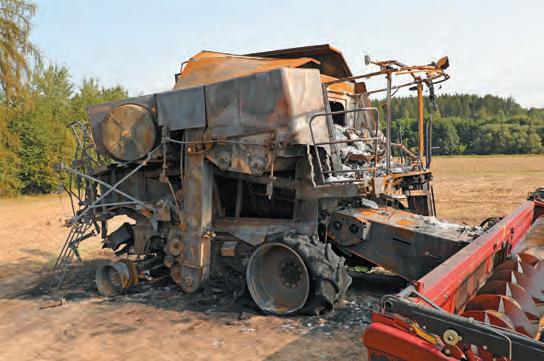Farmer adds to on-farm storage capacity By Tom C. Doran
AGRINEWS PUBLICATIONS
GRANVILLE, Ill. — Andy Gehm opted to be better prepared for weather-delayed and long, drawn-out harvests that create bottlenecks in the grain movement system. For the past 17 years, Gehm has been adding onfarm storage that provides him with greater efficiency and flexibility at harvest. The most recent addition was the installation of a 60-foot GSI bin with about 100,000 bushels of capacity along with a catwalk and conveyor that connect to the existing storage and drying system. This addition gives Gehm roughly 300,000 bushels of on-farm storage capacity. Gehm’s path toward expanding his on-site storage began in 2003 when he met with Tom Quick of T&S Quick Enterprises, a GSI dealer in Blackstone. “We came up with a plan to get some drying and storing capacity on the farm. Two 48-foot grain bins were erected in the spring of 2004 with holding capacities roughly of 60,000 bushels plus each. A dry leg and horizontal farm fan dryers were installed. I purchased an existing grain bin on the farm from my grandfather and we moved it to this site to use as a wet holding bin,” Gehm said. The system worked well and in realizing the number of benefits for having onfarm storage and drying he had a third 48-foot bin with overhead conveyor and catwalk installed by T&S Quick in 2009. “I really liked the extra storage and the lack of necessity of having to take grain to town,” he said. Gehm’s experience during the delayed 2009 harvest moved him to make further improvements to his on-farm capabilities. “We had a terribly wet fall in 2009 and I realized that I didn’t have sufficient drying capacity for the operation
AGRINEWS PHOTO/TOM C. DORAN
The 60-foot bin (far right) with a capacity of about 100,000 bushels was the most recent addition to Andy Gehm’s grain storage and drying system on his farm. This addition gives Gehm about 300,000 bushels of on-farm capacity and is all interconnected with GSI’s WatchDog automated system. Gehm’s storage expansion began in 2003 when he met with Tom Quick of T&S Quick Enterprises, a GSI dealer in Blackstone, Illinois, to develop a plan. that I wanted to run. So, in 2010 I went back to Tom Quick at T&S Quick again and we came up with a plan to install a tower dryer and a wet leg. I’ve been very pleased with every expansion project that I’ve done,” the fifth-generation farm explained. The latest project began in the spring of 2020 when he contacted Dale Middleton of T&S Quick and plans were made to erect the 60-foot bin and add onto the catwalk and conveyor to service that bin. The bin was ready for service in August. AUTOMATED SYSTEM The interconnected grain system includes GSI’s WatchDog that allows Gehm to remotely monitor and control dryer functions such as moisture, temperature and dryer status from a web-accessible device. “That’s really convenient to
capabilities. “Back in that terrible fall of 2009 my father and I sat down after that harvest season and we looked at the savings here with this facility in comparison to taking those bushels to town. The savings were absolutely staggering. So, I immediately saw the value of having your own dryer system. I knew it before, but that really magnified the value of having your own system,” Gehm said. “Not only did I realize the value of the drying system, equally I realized the value of on-farm storage somewhat for exactly the same reasons. I was able to keep my combine running that year when a lot of others in the area had to be stopping at noon give or take an hour or so because the local elevators just couldn’t handle the glut of such high ADVANTAGES Gehm noted the advan- moisture grain. tages he’s found in expanding his on-farm grain handling See STORAGE, Page 12 be at home and have an idea of what’s going on with the dryer or you could be hauling grain into the facility, running the combine, it doesn’t matter where you’re at, you can remotely monitor what the dryer is doing for you. It’s awfully nice. It let’s you know when you’re out of grain,” he said. “Everything is pretty much automated. When the dryer calls for grain, it receives grain from the wet bin. It’s constantly flowing out of the dryer and going into the bins. It’s full automation and then during the evening when I run out of grain, everything automatically shuts down and things are waiting for me in the morning to get a few loads in and get the dryer going again.”
Ag Mag – 11
BCR Ag Mag_111320.indd 11
11/5/20 7:28 AM







